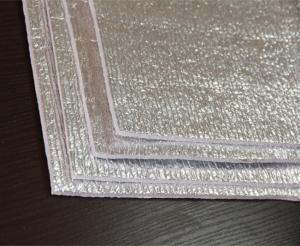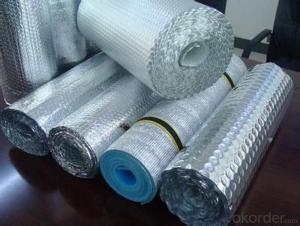Aluminum Foil Bubble Flat Roofing Insulation Boards
- Loading Port:
- Shanghai
- Payment Terms:
- TT OR LC
- Min Order Qty:
- -
- Supply Capability:
- 10 m²/month
OKorder Service Pledge
OKorder Financial Service
You Might Also Like
This is a new environmentally friendly aluminum foil bubble heat insulation material, which is soft, light and easy to install. It is made from aluminum foil and polyethylene through special machinery.
Function:
Can be installed on roof, wall or floor, resist over 80% external heat from buildings, protect wall, resist thermal shock and sudden cold, etc.
Characteristics:
1.No odor and toxicity, environmentally- friendly;
2.Moisture barrier, sun-proof, waterproof, good sealing property, heat preservation, energy saving…
3.Heat reflection, heat insulation, sound insulation, anti-radiation, anti-vibration, and shielding;
4.Light, soft, dust free, fire retardant, easy to install;
5.Summer: moisture barrier, sun-proof, heat insulation, saving energy consumed by cool air conditioning ;
6.Winter: heat preservation, central heating saving, and remarkable energy-saving effect.
Product: fireproof material
Technical parameters:
Material structure: AL/bubble/AL | ||
Bubble size: ¢10mm, H 4mm | ||
Bubble weight: 0.13 KG/M2 | ||
Roll size: 1.2M W*40M L (can be customized) | ||
PROPERTIES | Test Data | Unit |
Thickness | 3.5 | MM |
Weight | 256 | G/M2 |
Emissivity | 0.115 | COEF. |
Thermal conductivity | 0.034 | W/M0 |
Apparent Density | 85 | KG/M3 |
Reflectivity | 95-96 | % |
Water Vapour Transmission | 0.013 | G/M2 KPA |
Corrosion | Doesn't generate |
|
Tensile strength (MD) | 16.98 | Mpa |
Tensile strength (TD) | 16.5 | Mpa |
Usage:
1. Roof, wall, floor;
2. Shells of air conditioner and water heater;
3. Protective coatings of water pipe and ventilating pip
- Q: Our roof tile is installed on top of galvanized iron sheets. We do not have any toher form of insulation. The roof tile or tegula is quite thick.
- Yes, you do need other insulation. If you are on a budget, check craigslist, often people have leftovers from a project., frequently for free! You can mix and match, blown, fiberglass, whatever! Just one note of caution, however: If you have electrical boxes sticking up into the attic space, for recessed lights, make SURE they are rated for contact with insulation, or leave a little space around them.
- Q: I am really confused about this science stuff! Sustainability is terrible xP
- All versions of insulation are largely air that is kept from moving - air is a good insulator if convection - movement of heated or cooled air due to changes of density - is prevented. This assumes that a vapor barrier and caulking prevent actual air movement through the wall when a wind is blowing. Some insulators are also poor conductors of heat so the connection between inside and outside that might occur is broken. As it happens, glass used in fiberglass and minerals used in rock wool are actually pretty good conductors of heat in solid form but as fine particles and flakes they don't conduct well from one strand/piece to the next.
- Q: this room has an aluminum roof and hardwood siding. All the heat hit the aluminum roof
- Spray on expanding foam is best, paint on radiant barrier may work, blow in insulation in attic (cellulose or fiberglass) or put 12"x12" Styrofoam ceiling tiles on the ceiling, they look decent and not to expensive, installs with latex adhesive or staples. Good luck
- Q: please help..
- too add to that housing insulation wouldnt help you with dampening it would make it worse by absorbing the sound, try talking through a pillow for example/
- Q: weather stripping/ foam strip?
- I'm assuming your talking about a ridge cap normally you would seal it in with tar or polyurethane caulk and put your shingles over it
- Q: roof was replaced eight years ago soon after there were leaks in the roof caused insulation toget wet then dry now the insulation is packed hard and has started to turn into power who would be responsible to replace the insulation.
- Sorry; I don't know of any roofer that would take responsabilty after eight years. Unless your insurance might be an option. Check with them and decide if your deductable is more than the repair if you would be better off doing it yourself. I would also be concerned about underlying materials, sheet rock, lumber, MOLD. You need someone to check thoroughly for mold being as it has been so long. GOod luck; Flip;
- Q: How do I adequately insulate my attic roof to make the space a bit more habitable in the winter? The floors to the living area below are already insulated and we have a gable mounted fan which is great in the summer. I am thinking of adding insulation to the roof with baffles underneath for air circulation through the soffit vents. Am I anywhere near an idea that may work?
- you live in the conditioned air box! you can't change your wall insulation, just add more to the ceiling. don't block roof vents as they are as important in winter as summer. if you have an unfinished basement, you may want to consider sealing off the joist with plastic or tyvek depending on your conditions ( north or south ). most bang for the buck is ceiling insulation.
- Q: i live in a tropical country and i need to insulate my roof to block off the heat from the sun...which insulation would best help me? aluminum foil with foam, real foil with foam or PE with foam? pls help...thank u so much!
- Expanded polystyrene (EPS) comes in sheets and is very long lasting and safe to use - no fibers, no itchy skin, no breathing issues....this is also used to keep cold out as well as heat and is durable.
- Q: Tax Question: Itemized receipt for roofing and insulation?
- I choose the best answer based on the fact that he was correct. Our installation of the roof tiles was not a tax deductible item, but the extra insulation they installed was tax deductible, giving us an over extra $350 in return. We were just going to forget it, but it was actually worth it!
- Q: I added a screened room to my mobile home. I also have vinyl windows. in the summer the sun beats down on the home almost all day Someone told me I could have insulation installed in the roof panels, and that i may even be able to do it myself. Right now it's impossible to enjoy my patio between 1-5pm because it so hot you can't breath. I'm in the Pasco, FL area - 34667Appreciate any help you can give
- Yes you can....you can use metal strapping to hold up 2" foam insualation to the underside of the metal roof that you can get at Home Depot, Lowes, or any hardware store good luck
Send your message to us
Aluminum Foil Bubble Flat Roofing Insulation Boards
- Loading Port:
- Shanghai
- Payment Terms:
- TT OR LC
- Min Order Qty:
- -
- Supply Capability:
- 10 m²/month
OKorder Service Pledge
OKorder Financial Service
Similar products
Hot products
Hot Searches
Related keywords
























